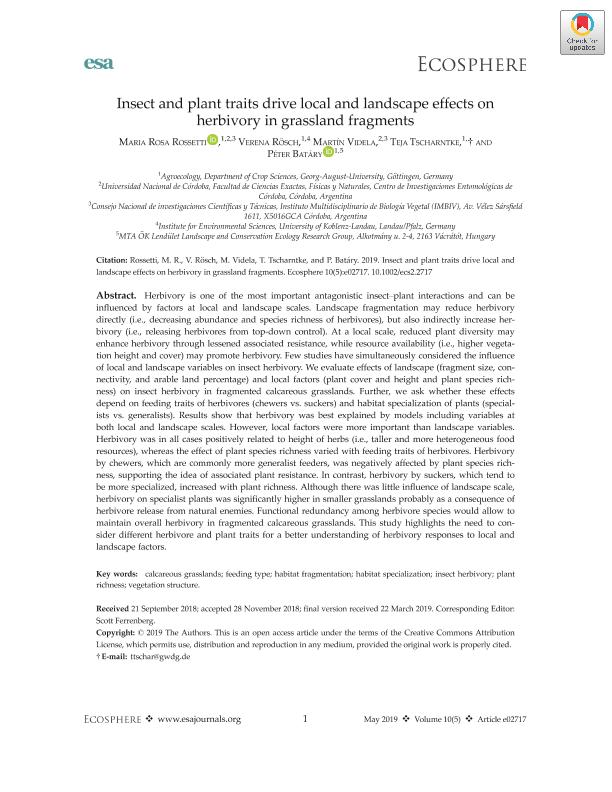Mostrar el registro sencillo del ítem
dc.contributor.author
Rossetti, María Rosa

dc.contributor.author
Rösch, Verena
dc.contributor.author
Videla, Martin

dc.contributor.author
Tscharntke, Teja
dc.contributor.author
Batáry, Péter
dc.date.available
2020-09-08T22:14:51Z
dc.date.issued
2019-05
dc.identifier.citation
Rossetti, María Rosa; Rösch, Verena; Videla, Martin; Tscharntke, Teja; Batáry, Péter; Insect and plant traits drive local and landscape effects on herbivory in grassland fragments; Wiley-Blackwell; Ecosphere; 10; 5; 5-2019
dc.identifier.uri
http://hdl.handle.net/11336/113580
dc.description.abstract
Herbivory is one of the most important antagonistic insect-plant interactions and can be influenced by factors at local and landscape scales. Landscape fragmentation may reduce herbivory directly (i.e., decreasing abundance and species richness of herbivores), but also indirectly increase herbivory (i.e., releasing herbivores from top-down control). At a local scale, reduced plant diversity may enhance herbivory through lessened associated resistance, while resource availability (i.e., higher vegetation height and cover) may promote herbivory. Few studies have simultaneously considered the influence of local and landscape variables on insect herbivory. We evaluate effects of landscape (fragment size, connectivity, and arable land percentage) and local factors (plant cover and height and plant species richness) on insect herbivory in fragmented calcareous grasslands. Further, we ask whether these effects depend on feeding traits of herbivores (chewers vs. suckers) and habitat specialization of plants (specialists vs. generalists). Results show that herbivory was best explained by models including variables at both local and landscape scales. However, local factors were more important than landscape variables. Herbivory was in all cases positively related to height of herbs (i.e., taller and more heterogeneous food resources), whereas the effect of plant species richness varied with feeding traits of herbivores. Herbivory by chewers, which are commonly more generalist feeders, was negatively affected by plant species richness, supporting the idea of associated plant resistance. In contrast, herbivory by suckers, which tend to be more specialized, increased with plant richness. Although there was little influence of landscape scale, herbivory on specialist plants was significantly higher in smaller grasslands probably as a consequence of herbivore release from natural enemies. Functional redundancy among herbivore species would allow to maintain overall herbivory in fragmented calcareous grasslands. This study highlights the need to consider different herbivore and plant traits for a better understanding of herbivory responses to local and landscape factors.
dc.format
application/pdf
dc.language.iso
eng
dc.publisher
Wiley-Blackwell
dc.rights
info:eu-repo/semantics/openAccess
dc.rights.uri
https://creativecommons.org/licenses/by-nc-sa/2.5/ar/
dc.subject
CALCAREOUS GRASSLANDS
dc.subject
FEEDING TYPE
dc.subject
HABITAT FRAGMENTATION
dc.subject
HABITAT SPECIALIZATION
dc.subject
INSECT HERBIVORY
dc.subject
PLANT RICHNESS
dc.subject
VEGETATION STRUCTURE
dc.subject.classification
Ecología

dc.subject.classification
Ciencias Biológicas

dc.subject.classification
CIENCIAS NATURALES Y EXACTAS

dc.title
Insect and plant traits drive local and landscape effects on herbivory in grassland fragments
dc.type
info:eu-repo/semantics/article
dc.type
info:ar-repo/semantics/artículo
dc.type
info:eu-repo/semantics/publishedVersion
dc.date.updated
2020-09-02T19:06:50Z
dc.identifier.eissn
2150-8925
dc.journal.volume
10
dc.journal.number
5
dc.journal.pais
Estados Unidos

dc.description.fil
Fil: Rossetti, María Rosa. Universidad Nacional de Córdoba; Argentina. Consejo Nacional de Investigaciones Científicas y Técnicas. Centro Científico Tecnológico Conicet - Córdoba. Instituto Multidisciplinario de Biología Vegetal. Universidad Nacional de Córdoba. Facultad de Ciencias Exactas Físicas y Naturales. Instituto Multidisciplinario de Biología Vegetal; Argentina. Universität Göttingen; Alemania
dc.description.fil
Fil: Rösch, Verena. Universitat Koblenz; Alemania. Universität Göttingen; Alemania
dc.description.fil
Fil: Videla, Martin. Universidad Nacional de Córdoba; Argentina. Consejo Nacional de Investigaciones Científicas y Técnicas. Centro Científico Tecnológico Conicet - Córdoba. Instituto Multidisciplinario de Biología Vegetal. Universidad Nacional de Córdoba. Facultad de Ciencias Exactas Físicas y Naturales. Instituto Multidisciplinario de Biología Vegetal; Argentina
dc.description.fil
Fil: Tscharntke, Teja. Universität Göttingen; Alemania
dc.description.fil
Fil: Batáry, Péter. Universität Göttingen; Alemania. Mta Ök Lendület Landscape And Conservation Ecology Research Group;
dc.journal.title
Ecosphere
dc.relation.alternativeid
info:eu-repo/semantics/altIdentifier/doi/http://dx.doi.org/10.1002/ecs2.2717
dc.relation.alternativeid
info:eu-repo/semantics/altIdentifier/url/https://esajournals.onlinelibrary.wiley.com/doi/full/10.1002/ecs2.2717
Archivos asociados
